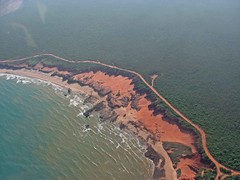 |
| James Price Point S34964 (Photo credit: yaruman5) |
The proposed Browse Liquefied Natural Gas Hub at James Price Point (known locally as Walmadany), 50km north of Broome, has created one of the most fiercely fought environmental and indigenous battles currently occurring in Australia.
Despite the existence of alternative brown field sites (such as Karratha), the State Government prefers James Price Point even though it is likely to be a far more expensive option (an estimated $15 billion) for joint venture partners Woodside, BP, BHP, Shell and Mitsui/Mistubishi, and tax payers.
The James Price Point option is also far more pristine, biodiverse and ecologically significant, with a rich indigenous connection to country. The area is abundant with indigenous songcycle pathways, burial grounds, the Lurujarri Heritage Trail, calving Humpback whales, dugongs, dolphins, abundant fishes, coral reefs, seagrass, remnant rainforest, dinosaur trackways and breeding bilbies.
The area is so ecologically and culturally rich that it was recommended for National Park protection by the Australian Academy of Sciences and the National Parks Board of WA in 1962; the WA Environmental Protection Authority in 1977 and 1993; the WA Department of Conservation and Land Management in 1991; the Broome Shire, Department of Land Administration and WA State Cabinet in 2000; and the Broome Planning Steering Committee in 2005.
This is all at odds with the state premier Colin Barnett’s description of the area as an “unremarkable” piece of coastline.
The WA Environmental Protection Authority (EPA) recently completed an initial assessment. A further assessment is due from the Federal Environment Minister at the end of the year. The WA EPA based their assessment on the Strategic Assessment Report (SAR) prepared by the state government for the project, giving the project the green light.
As the proposed gas hub is one of the largest industrial projects in Australia’s history and will become the largest gas hub in the world, one would expect the environmental impact assessment to be well considered, comprehensive, robust and based on sound science. Unfortunately the EPA’s assessment fell far below these expectations.
Major issues occurred in the assessment process itself. The state government recognised that - due to the scale and complexity of the project - they’d need a high level of confidence in the science underpinning the SAR. They recommended establishing a peer review process. This didn’t happen: only the minority of the science was scrutinised and only when major inadequacies were revealed by independent and citizen scientists.
This leaves little confidence and much uncertainty in the quality of the SAR’s science on which the EPA based their assessment. When the assessment was undertaken, four out of five EPA board members had to be excluded due to conflicts of interest, leaving a “quorum” of one.
As three of these conflicted members were excluded only months before the completion of the five year assessment, there was ample opportunity for their conflicts to influence the process.
Despite these procedural issues, how did the EPA justify impacts to the significant ecological communities and species of James Price Point? For brevity I will focus on two of the most significant ecological features of the area.
One of the most striking and significant ecological features of the James Price Point area is the monsoon vine thicket that occurs behind the coastal dunes. This little-studied remnant rainforest is incredibly diverse, containing 25% of all plant species from the Dampier Peninsula and up to 70 species of ants.
This rainforest also contains one of the highest densities of bush tucker and medicinal plants in Australia and is therefore critically significant to the local indigenous people. Poor fire management, weeds and land clearing have led to fragmentation and declines in these communities. The communities are currently under assessment for federal listing as a threatened ecological community.
To read further, go to: http://theconversation.edu.au/james-price-point-environmental-significance-ignored-in-failed-impact-assessment-8817?utm_medium=email&utm_campaign=Latest+from+The+Conversation+for+23+August+2012&utm_content=Latest+from+The+Conversation+for+23+August+2012+CID_50f943b8e72296edeba130463220fa19&utm_source=campaign_monitor&utm_term=James+Price+Point+environmental+significance+ignored+in+failed+impact+assessment




























